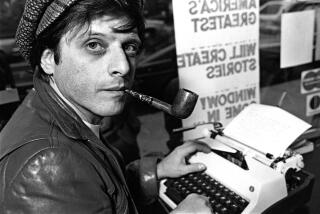A Pioneering Spirit in Pen and Ink
It was 1937, the dawn of the golden age of comics, and an unemployed 19-year-old named Will Eisner seized upon an opportunity.
Depression-weary Americans, hungry for escape and excitement, were immersing themselves in cheap detective dramas, space fictions and superhero sagas. Demand for tales about Dick Tracy, Flash Gordon and others seemed bottomless. Syndicators and pulp magazine publishers were snapping up popular newspaper strips and reprinting them in pamphlets, magazines and paperback books. They struggled to keep up with the pace.
Eisner approached an out-of-work colleague, 32-year-old Jerry Iger, with a proposition: Why not form a comic strip production company and sell original strips to the desperate publishers? There was no competition to speak of; the two were almost guaranteed success.
With $15 as starting capital, the fledgling firm of Eisner & Iger opened shop in a tiny office on East 41st Street in New York.
âIt was in a building mostly used by bookies,â Eisner, now 83, said. âThe rent was $5 a month, so I figured we had enough rent for three months.â
Iger assured publishers that the two had an âimpressive staff that could crank out complete books of remarkable quality,â Eisner said.
In reality, the staff was Eisner, who worked day and night to churn out strips with different styles under five aliases. Within a short time, though, his well-crafted strips proved a huge success. Money flowed in. By 1939, Eisner & Iger had so much work, it had to hire 15 employees to do its drawing, inking and lettering.
From the get-go, Eisner believed that comic strips--or sequential art, as he preferred to call them--had enormous potential. In the right authorsâ hands, he said, the medium could educate and influence âwith a mental transmission greater than words alone.â
âIâve always regarded this medium as a valid literary form capable of doing much more than telling jokes,â he said.
If anyone could take the genre to a new level, Eisner could. Over the course of his career, he would establish himself as one of its most skilled and innovative creators.
His interest in comic strips began in childhood. Heâd been encouraged to pursue art as a vocation by his father, a Viennese immigrant who painted iron beds and Yiddish theater sets. During the Depression, Eisner supplemented his familyâs income as a paperboy, regularly taking home five or six newspapers to pore over their strips. He also read voraciously.
âMy literary nutrition was short stories,â he said. In particular, he was inspired by the Horatio Alger tales, which emphasized that diligent, hard work paid off.
At DeWitt Clinton High School in the Bronx, Eisner immersed himself in art-related activities. He became art director for the schoolâs magazine, designed sets for plays and had his first comic strip published in the school newspaper.
After graduation, he spent a summer on scholarship at the Art Students League, then did stints as an advertising firm artist and printerâs assistant before becoming a freelance comic strip artist.
It was during his successful tenure at Eisner & Iger that he was approached by the Register & Tribune syndicate to create a new comics format: a 16-page insert to be distributed to major newspapers throughout the United States. Eisner leaped at the opportunity--âthough Iger thought I was crazy,â he said. Eisner then sold his share of the firm to Iger.
The following year, Eisner launched a groundbreaking strip called âThe Spirit,â about a masked crime fighter who operated out of a cemetery. Unlike other adventure-strip protagonists of the time, the Spirit had no superpowers; he got by on his wits.
Eisner, then 23, had struck a hard deal with his syndicators. Though tradition dictated that artists and writers had to relinquish their copyrights and accept flat rates, Eisner demanded that he retain ownership of the strip. He said it would allow him creative freedom. Because the strip was heatedly sought after, he got his wish. The Spiritâs adventures soon appeared weekly as a seven- or eight-page-long tabloid insert in newspapers across the country.
During the next few years, Eisner unleashed a string of innovations. Using film as inspiration, he sketched his strip panels like camera shots, incorporating birdâs-eye and wormâs-eye views, for example. He introduced the âsplash page,â an opening page with titillating content that foreshadowed the action ahead. It was similar to a film trailer.
He also manipulated panels to express speed, excitement and climaxes and designed lettering to bolster mood and tone.
âEven now the guys doing really great stuff, who are pushing the envelope, still look back on the things he did in the â40s and canât figure out how he did it,â said Jeff Smith, creator of the comic strip âBone.â
Artists soon competed to work at Eisnerâs studio. Talents such as Jack Kirby, who later created Captain America and the Incredible Hulk; Bob Kane, creator of Batman; and cartoonist Jules Feiffer contributed to the strip. Readership soared, but then World War II broke out and Eisner received a draft notice.
Recruitment didnât quash Eisnerâs creativity, though. He saw his conscription as a chance to employ sequential art in a new way. Turning his strip over to staff, he proposed to military superiors that he create a series of safety posters featuring Joe Dope, a careless recruit. His project was so well-received that he earned a transfer to the Pentagon, where he edited Firepower, an Army publication, and created comic-book-style military training manuals.
Tests showed that servicemen retained more through Eisnerâs methods than they did from traditional text-and-photo manuals.
Eisner was discharged in 1946. He returned to New York a changed man, more interested in expanding sequential artâs uses than in continuing to produce his strip. After a few more years at the helm of âThe Spirit,â Eisner finally decided to end its publication in 1952.
âBy that time, âThe Spiritâ held no more attraction for me,â Eisner said. âWhen I emerged from the Army, Iâd grown up considerably. I had a different perspective of the world. I was more interested in writing about people than in fantasy adventure.
âI get my kicks from innovations, from trying new ideas and experimenting. For me, those are the things that make life worthwhile.â
He founded the American Visuals Corp. to create educational comic strips for businesses, schools and the government. This would remain his mission for the next 20 years.
He had no incentive to return to comic strip production: Congressional investigations in 1951 and 1954, coupled with the release of Frederic Werthamâs cautionary booklet, âSeduction of the Innocent,â had concluded that comic books contributed to juvenile delinquency. Publishers began censoring their material. What followed was an era of sentimental domestic dramas such as âRex Morgan MD,â âMary Worthâ and âThe Heart of Juliet Jones.â
But in the early 1970s, at a friendâs urging, Eisner attended a comic book convention. What he found there shocked and delighted him. Young artists were turning out underground comics with themes of political and social protest. Their creations stirred him to consider returning to the trade. His new goal, he said, was to become âan author who writes with pictures.â
In 1978, Eisner released Americaâs first graphic novel, âA Contract With God and Other Tenement Stories.â Told in words and pictures, his four stories focused on immigrant life in New York during the 1930s. The following year, Jules Feiffer would release his own graphic novel, âTantrum.â And in 1986, Art Spiegelman would publish the first of his Pulitzer Prize-winning âMausâ graphic novels about the Holocaust.
Since releasing âContract,â Eisner has published 14 more books. They deal not with superheroesâ tribulations, but with the struggles of ordinary people. âLast Day in Vietnam: A Memoryâ (Dark Horse Publications, 2000) features stories set in World War II, the Korean War and Vietnam. The characters are based on people Eisner, who continued to work on military magazines, met during those wars. âFamily Matterâ (Kitchen Sink Press, 1998) addresses the challenges of a family whose 90-year-old patriarch has suffered a paralyzing stroke.
Though graphic novels still donât enjoy the popularity in America that they do in Europe and Japan, Eisner is optimistic about their future here. Heâs witnessed the novels become required reading by universitiesâ English, Jewish studies and comparative literature departments.
Eisner, who lives in Tamarac, Fla., remains an ambassador of sequential art through his instruction of up-and-coming artists. From 1974 to 1993, he taught courses in the genre at New Yorkâs School of Visual Arts. Heâs also served as a mentor for many now-successful comic strip artists, including Ray Billingsley, author of the âCurtisâ strip, who recalled how Eisner continually challenged him to innovate.
âHe really tutored me well,â Billingsley said. âWill was there to train us as professionals. As a teacher, he was very, very serious aboutâ the discipline.
As he watches new generations enter the field, Eisner has mixed emotions. He praises the latest crop of aspiring graphic novelists for their savvy: âThe general intellect of people working in the field today is far higher than when I started out in 1940.â
But he worries that the art of storytelling is fading.
âWeâve lost our sense of wonder,â he said. âLife experience for young people nowadays is largely artificially acquired, through television and film. I find this with my students.â The best tales, Eisner said, emerge from authorsâ personal challenges.
Eisner is hard at work on yet another graphic novel, whose theme he is reluctant to disclose. He works on it daily, a page a day. His goal is to continue to produce fresh, thought-provoking material.
âItâs very rare in any artistic form to have someone in his 80s setting the standard for the craft,â said Paul Levitz, executive vice president and publisher for DC Comics in New York. âHeâs proven himself an unusual combination of creative and entrepreneur.â
Added Scott McCloud, author of âUnderstanding Comicsâ (Kitchen Sink, 1994) and a close friend of Eisnerâs, âWill is very young for his age. He jokes that his real ambition is to win the award for most promising young cartoonist.
âYou know, I think heâs only half-joking.â
(BEGIN TEXT OF INFOBOX / INFOGRAPHIC)
Tips for Getting Ahead
Will Eisner is considered by many to be the father of the graphic novel and the grandmaster of comic book art. Here are his tips for aspiring graphic novelists:
1. Develop top-notch art skills. In particular, study anatomy and learn how to draw people. Practice regularly. Carry a sketchbook with you and sketch the people you meet and observe.
2. Read widely. Be well-informed. This way youâll be able to generate more ideas for your own original tales.
3. Learn more about the graphic novel medium. Study the graphic novels of successful authors. See how theyâre able to convey ideas using text in combination with art.
4. Compare and contrast the media of graphic novels and film. Though they have some similarities, their deployment of images is different. Youâll be creating still images for your readers, not animated images, so youâll need to become proficient in this special skill. Donât merely borrow effects from film, as some wonât work.
5. Stick to it. Work every day to improve your skills.
More to Read
Sign up for our Book Club newsletter
Get the latest news, events and more from the Los Angeles Times Book Club, and help us get L.A. reading and talking.
You may occasionally receive promotional content from the Los Angeles Times.







